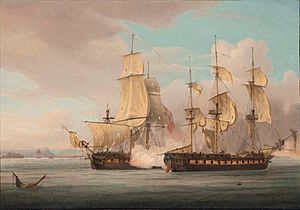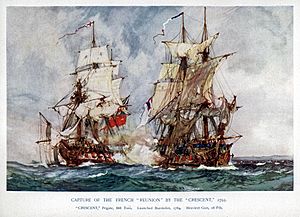Action of 20 October 1793 facts for kids
Lua error in Module:Coordinates at line 614: attempt to index field 'wikibase' (a nil value).
Quick facts for kids Action of 20 October 1793 |
|||||||
|---|---|---|---|---|---|---|---|
| Part of the French Revolutionary Wars | |||||||
 HMS Crescent, under the command of Captain James Saumarez, capturing the French frigate Réunion off Cherbourg, 20 October 1793, Thomas Whitcombe |
|||||||
|
|||||||
| Belligerents | |||||||
| Commanders and leaders | |||||||
| Strength | |||||||
| 2 frigates | 1 frigate 1 cutter |
||||||
| Casualties and losses | |||||||
| 1 wounded | 81 killed and wounded 1 frigate captured |
||||||
The Action of 20 October 1793 was a small but important naval battle. It happened off the coast of France in the English Channel. This fight was part of the bigger French Revolutionary Wars, which had started in February 1793.
During the early part of the war, French ships called frigates were attacking British merchant ships. These attacks were happening in the Channel. To stop them, the British sent HMS Crescent. This ship was led by Captain James Saumarez. His job was to watch the port of Cherbourg-en-Cotentin. Two French frigates, Réunion and Sémillante, were based there.
On October 20, Saumarez was waiting near Cape Barfleur. His lookouts spotted Réunion and a smaller ship called Espérance. Saumarez quickly moved to attack the French frigate. He managed to separate Réunion and fired at it for over two hours. The French ship was badly damaged. It lost many crew members. The British ship, Crescent, had only one person injured.
Eventually, the French captain, François A. Dénian, had to give up. This happened when another British ship, HMS Circe, arrived. Réunion was later fixed and joined the British navy. Captain Saumarez was made a knight for his success.
Why the Battle Happened
The war between Great Britain and France began in early 1793. The French Revolutionary Wars were already a year old. The French Navy was having problems. This was because of the French Revolution. Many experienced officers had left. But the Royal Navy was ready for action.
In the first months of the war, the French Navy focused on raiding. They used their fast frigates to attack British merchant ships. In the English Channel, two successful French ships were Réunion and Sémillante. They sailed from Cherbourg. These ships would leave in the evening. They would return in the morning with any ships they had captured.
To stop these attacks, the British Admiralty sent warships. One of these was the 36-gun frigate HMS Crescent. Captain James Saumarez commanded her. She sailed from Portsmouth to the Channel Islands. Then she patrolled off the French coast.
On October 19, Saumarez learned about the French ships' routine. He took up a position near Cape Barfleur. This was a rocky point that the Cherbourg ships passed. At dawn on October 20, lookouts on Crescent saw two ships. They were approaching from the Channel. One was much larger than the other. Saumarez immediately moved his ship. He sailed towards the new vessels. He quickly came up on the left side of the French ships. The wind was behind him, which gave him an advantage.
The Fight Begins
The two ships Crescent found were the 38-gun frigate Réunion. The other was a 14-gun cutter called Espérance. They were returning from a raiding trip. Captain François A. Dénian commanded Réunion.
Réunion was a bigger ship than Crescent. It weighed 951 tons, while Crescent was 888 tons. Réunion also had more crew, 300 men compared to Crescents 257. However, Crescent had a slight advantage in firepower. Its cannons could fire a total of 315 pounds of shot. Réunions could fire 310 pounds. Also, Crescent was faster. It had just been repaired and updated.
The battle started at 10:30 in the morning. The cutter Espérance sailed away towards Cherbourg. Another British ship, HMS Circe, was nearby. It was about 9 miles away. But it could not join the fight. The winds were too calm for Circe to reach them.
At the start of the battle, both ships' sails and ropes were damaged. Crescent lost its front topmast. Réunion lost its front yard and rear topmast. To gain an advantage, Saumarez quickly turned his ship. He used the damage to Réunion to his benefit. The French ship could not move well. Saumarez then fired several "raking broadsides" into Réunion's back. This means he fired along the length of the ship. This caused huge damage.
The raking fire caused massive damage and many injuries on the French ship. Captain Dénian kept fighting for a while. But his ship could not fight back effectively. Circe was now getting closer as the wind picked up. Dénian realized he had no choice. He surrendered his ship after two hours and ten minutes of fighting. The cutter Espérance had been ignored during the battle. It successfully escaped to Cherbourg. The captain of Sémillante, in the harbor, tried to help. But strong winds and tides stopped his ship from sailing out.
After the Battle
Both ships were damaged in the fight. But Crescent's damage was mostly to its rigging (sails and ropes). Very few shots hit its main body. Only one shot caused notice. It passed across the deck without hurting anyone. It hit a cannon on the other side, making it fire. This shot went towards some small gunboats coming from the shore.
Injuries on Crescent were very light. Only one man was hurt. He had been too close to his own cannon when it fired. The cannon recoiled and hit him, breaking his leg. Damage and losses on the French ship were very severe. Its rigging was torn. The hull and lower masts were hit many times. Saumarez first thought over 120 French men were killed or wounded. But French records later said 33 were killed and 48 wounded.
Saumarez was highly praised for his actions. This was only the second successful frigate battle for the British in the war. The first was when Edward Pellew captured Cléopâtre four months earlier. As a reward, King George III made Saumarez a knight. The City of London also gave him a special plate.
However, Saumarez later received a bill for £103 6 shillings and 8 pence. This was for "the honour of a knighthood." Saumarez refused to pay. He told the person to charge whoever paid for Edward Pellew's knighthood. Saumarez later wrote to his brother. He said, "I think it hard to pay so much for an honour which my services have been thought to deserve."
Because of his success, Saumarez was later given command of a group of frigates. They operated off the Normandy coast. Also, the first officer, George Parker, was promoted. The other two officers were also praised.
Réunion was bought by the Royal Navy after it was repaired. It became HMS Reunion. It was rated as a 36-gun frigate. It carried 12-pounder cannons. Money from the capture, called prize money, was given out. It was £5,239. This money was shared among the crews of Crescent and Circe. More than 50 years later, this battle was recognized again. A special clasp was added to the Naval General Service Medal. This was given to all British participants from Crescent who were still alive in 1847.
|


